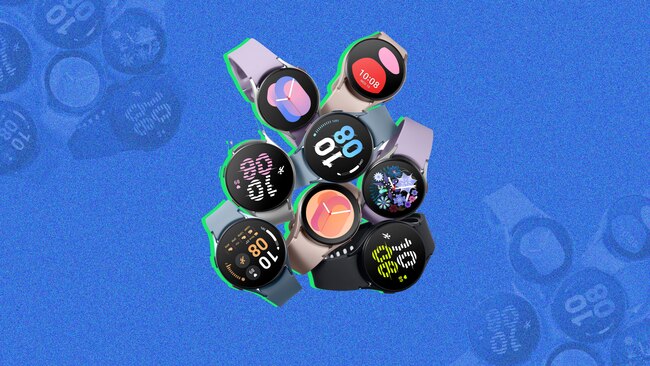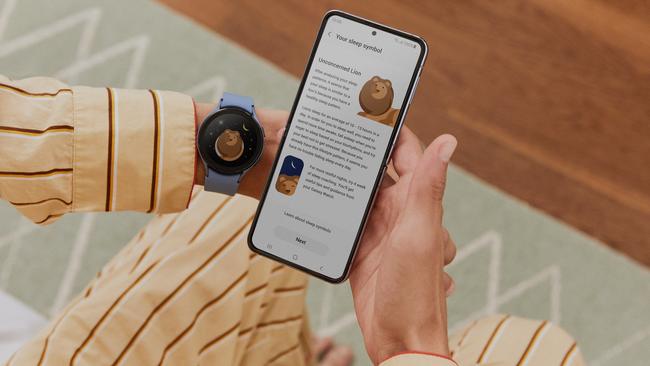Most personal device you can discuss in polite company
Samsung's Galaxy Watch5 is really a mixed bag, with some features just downright odd.

Samsung's Galaxy Watch5 is really a mixed bag, with some features just downright odd.
The smartwatch is really the most personal electronic device you can talk about in polite company.
They can serve many purposes, from saving you from looking at your phone as much, or as a tool to achieve your fitness goals. More regularly they’ve become wellness devices giving you insights into sleep, stress, heart rate, blood oxygen, fitness levels and other things that used to be purely in the realm of medicine and personal training.
Last week, Samsung announced two new watches: The Galaxy Watch5 (obviously superseding the Watch4) and the Galaxy Watch5 Pro (confusingly replacing the Watch4 Classic).
The Watch5 is aimed at people who want to be more aware of what’s going on with their health and possibly be reminded to move every now and then when they’re sitting in the office. Meanwhile, the Watch5 Pro is aimed squarely at people who would have opted for Garmin or Suunto fitness watches in the past - people who run very long distances, or ride their mountain bikes on the path less travelled. It’s a space the major phone brands haven’t ventured into before, and I have spent more than a week with the Watch5 Pro discovering what it has to offer.
Sleep
We all want to sleep better, and there have been so many devices released to tell you how you slept, but few actually give you actionable information to go with that. The Watch5 Pro seems to be changing that a bit, by offering sleep coaching with actionable tips. Most of those tips are along the lines of “go to bed at a consistent time”, “stop staring at your phone in the middle of the night” and “don’t sleep next to someone who sleeps like they’re imitating a rotisserie chicken, complete with heat source”, so we will likely ignore the tips. Still, it’s nice to be assigned a sleep animal (yes, really, you could be a Sensitive Hedgehog) and then have a month-long sleep coaching program made for you to see if you like the sleep improvements enough to stick with it.

Other sleep-related info includes sleep stages, snoring data, and blood oxygen while you sleep.
How accurate are all these sensors?
The problem is, though, that not all watch sensors are created equal, and one shouldn’t take these numbers as gospel at times that really matter. The blood oxygen sensor in the watch can’t replace a proper pulse oxygen monitor if you’ve got covid, for example. You shouldn’t rely on the ECG (Electrocardiography) to diagnose a heart attack, either. These kinds of numbers are to give you a general idea. You should seek medical attention if the numbers are bad, and also if the numbers are good but you feel bad. This is the same across all smartwatches – the metrics are there for entertainment value and to give you a ballpark, not to be used as medical devices.
The stress sensor is a fun idea, but during a time of high turbulence on a plane, the stress sensor in the watch said I was very calm.
Yesterday I nearly got hit by a truck while riding my bike and pulled over to catch my breath, and the watch still said I was calm.
Reader, I was not even mildly calm.
The only time it said I was actually stressed was when I was sending an email to a friend, so maybe it knows something I don’t. But, perhaps after it has more time to get to know me, it will learn.
In the case of body composition, though, the results should be completely ignored. Placing two fingers on the buttons of your watch can’t tell you how much fat or muscle you have. It’s as accurate as the sensors on the Fitbit, Withings and InBody scales, which is to say not even remotely accurate. In previous tests by Consumer Reports, it was found that these tests were off by at least 20%. That, paired with the use of BMI (which is an inaccurate and misleading metric formulated around 200 years ago, based on the “average European man” at the time, and bears little relevance to health in 2022 despite its widespread use) and colour coding of underweight as light green, “optimal” BMI of green, and “overweight” as orange can be triggering for people pre-disposed to eating disorders and body image issues.
The good news is that it’s fairly easy to reduce your exposure to this useless at best and harmful at worst test by removing it from the health carousel on the watch and moving it down the list in Samsung Health. Hopefully Samsung will one day change that colour scale to be more neutral, because I’m sure the company doesn’t mean any harm with the colours chosen for the scale. If you’re only thinking about losing weight, the colour scale used makes sense.
Fitness
One of my few complaints about the Apple Watch is that it doesn’t give as much actionable information during workouts as I would like. Heart rate zones are coming in Watch OS 9, but comparing the Watch5 Pro to my current Apple Watch Series 7, the Watch5 Pro is much clearer to read and gives more useful information at a glance. Heart rate zones can be a helpful tool for cardio interval workouts, to improve endurance, strength and fat burn based on your fitness that day, making for a more personalised workout. On the Watch5 Pro, it’s easy to read these zones and focus on them, or you can change screens to keep an eye on your average pace if you’re in a race.
That large screen makes it ideal for getting directions while cycling, too. However, while the Apple Watch will surface directions when you’re coming up to a turn, and make it clear through a series of vibrations where you need to go, even when you have a workout up, the Watch5 Pro dramatically fails on default settings. If you have directions and a workout going, it’ll be the workout stats that stay up, with the occasional vibration you need to guess to interpret whether it’s a lap, km, or turn notification. Hopefully this is something that will be fixed in a software update, because having to choose between a workout and directions, particularly if you have a Samsung Z Fold4 (get inside the fold here) and can’t get a Quad Lock case to mount your phone to your bike, is just ridiculous.
The GPS doesn’t just give you directions, it can also let you forge a path and remember it. There have been a few times where I’ve gone on a hike and wished I’d remembered the route I’d taken so I could share it with a friend or, more immediately, work out how on Earth to get back. The route recording option in the Watch5 Pro is super useful for that. It does require a data connection to do it well, so you can’t go too far off the beaten track, but it’ll suit most people.
I do wish you could compete on the routes you share and create like you can on Strava. These sharing features in no way replace dedicated social fitness apps, but it does go a step closer and it’ll be interesting to see what the future brings.
For walkers, the Watch5 Pro is unparalleled in its ability to automatically recognise and record walking, pausing when you pause. This is a feature that Apple says is too hard to implement in their watches, so it’s nice to be able to record all that incidental exercise without having to make a big deal about it. However, the Watch5 Pro doesn’t auto-detect or auto-pause cycling workouts, unlike the Apple Watch, so you have to pick your battles, I guess.
Those more in-depth fitness features aren’t new to people who have Garmin and Suunto watches. I have a couple of Suunto watches whose fitness features are exactly what I’m looking for on longer rides, and the route discovery on those watches is a great way to explore. But those more fitness-focussed watches lack the deep, easy Android integration you get from a Samsung watch that’s made to work perfectly with Samsung phones. Samsung-using fitness enthusiasts will be well served by the Watch5 Pro.
The best feature
The fitness stuff is all great, the huge screen is extremely useful, and the rugged materials used will survive a fall better than I will. But the best feature is the battery. I’m getting more than double the battery life from the Watch5 Pro than I do from my Apple Watch – around two and a half days between charges, even on days when I do multiple workouts.
Is it good?
For Samsung-using, fitness enthusiasts that don’t need the extra hardcore features of the Suunto 9, this is the best smart watch for them. There are some features I would like refined (and one removed entirely) but, overall, this is the best Android smart watch I’ve ever used.
The Samsung Galaxy Watch5 Pro is available from September 2.
Alice Clarke travelled to New York as a guest of Samsung. Read her review of the new Samsung Buds2 Pro here.


